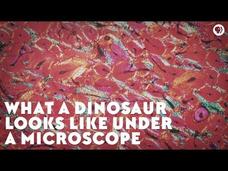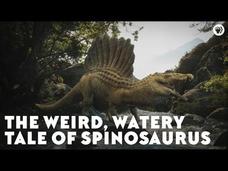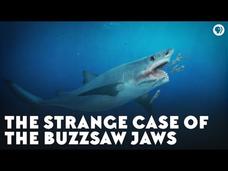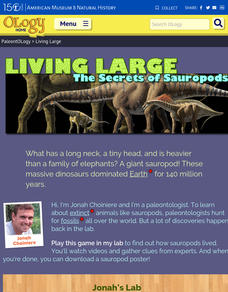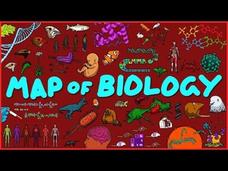PBS
What a Dinosaur Looks like under a Microscope
How do scientists determine the age of a dinosaur when it died? Viewers earn how scientists make slides of dinosaur fossils and how they use these images to determine age at death. Part of a larger Eons series from PBS, these beautiful...
PBS
The Weird, Watery Tale of Spinosaurus
While scientists have know about dinosaurs that flew in the air, lived on land, and swam in the water, a episode from the PBS Eons series reveals recent discoveries of a dinosaur that was semi-aquatic—the first known semi-aquatic...
PBS
The Strange Case of the Buzzsaw Jaws
Shark teeth in Idaho, China, and Russia confused scientists for hundreds of years. A spiral of sharp teeth presented the first clue, but where would they even go on a shark? Learn more about the strange case in a video that is part of a...
Crash Course
Why the Evolutionary Epic Matters: Crash Course Big History #203
Imagine a world where the only animals roaming the earth are domesticated. One day, we might not have to imagine the scenario of no wild animals—and that day approaches faster than predicted. A video explains the evolution from...
TED-Ed
How to Fossilize Yourself
Here is an unusual question: How can I become a famous fossil for future generations to examine and adore? It is from this comical perspective that viewers learn how fossilization occurs. Show this for your middle school paleontologists...
American Museum of Natural History
Living Large
Get to know all about sauropods from a paleontologist, Jonah. Following an introductory video, scholars choose from five fossils to learn more about. Each fossil begins with a video, provides information from several different...
American Museum of Natural History
Ask a Scientist About T. Rex
With its small arms and giant body, many children are fascinated by the T-Rex. Use the online resource to learn about the characteristics of the T-Rex and how scientists study the extinct species. A paleontologist answers a series of...
Domain of Science
The Map of Biology
Many define biology as the study of life but can't agree on a definition of life. Trying to explain all of the domains and subdomains of biology seems a bit easier than defining life. See a full map of the topics covered by the general...
PBS
The Whole Saga of the Supercontinents
See the world as it was—and also how it will be! A riveting video from a vast biology and earth science playlist takes viewers back in time to see how supercontinents formed, broke apart, and formed again. The resource includes a sneak...
PBS
Untangling the Devil's Corkscrew
How did scientists unravel the mystery of an ancient beaver species? An engaging video from a well-written biology playlist discusses the discovery of strange spiral fossils found in Nebraska farm country. Junior paleontologists examine...
PBS
What Happened to the World's Greatest Ape?
Gigantopithecus was the greatest of the great apes! Whatever became of them? Take a journey to Asia and explore the forests and grasslands that were once home to the large primate using a video from an extentsive biology playlist....
PBS
An Illustrated History of Dinosaurs
Science and art influence each other, and a visual study of dinosaurs based on artwork throughout time introduces an interesting topic. The video from the PBS Eons channel features Hank Green. It highlights artwork from the earliest...
The Brain Scoop
Fossil Meteorites
Fossils ... from space? Science scholars discover evidence in a limestone quarry that helped researchers learn about a meteor shower that lasted hundreds of thousands of years through an interesting video from Brain Scoop's Fossils and...
The Brain Scoop
Dimetrodon Is Not A Dinosaur
Dimetrodon—the dinosaur that wasn't really a dinosaur! Explore the facts about an animal that lived before the Jurassic era with a fact-filled video from Brain Scoop. The narrator shows dimetrodon's characteristics, its common...
The Brain Scoop
Bending Fossils: Experiments In Paleontology (Harvard Adventures, Part 3)
How can we bend a fossil? Junior paleontologists explore the joint movements of extinct species in Brain Scoop's Fossils and Geology series. The narrator works with a paleontology curator to show the experiments performed on the...
The Brain Scoop
Fisher Dissection: Harvard Adventures, Part 2
What can we learn about the evolution of mammals from a fisher? An engaging video from Brain Scoop's fossils and geology series illustrates the anatomical features of mammals through the dissection of a fisher. Content includes the...
The Brain Scoop
The Origin of Mammal Movement: Harvard Adventures, Part I
It may be difficult for some humans to walk and chew gum at the same time ... but reptiles can't breathe while running at all! Compare the skeletal systems of reptiles and mammals in the first installment of Brain Scoop's fossils and...
The Brain Scoop
Tully Monster Mystery Solved!
What is the Tully Monster? Introduce your science classes to one of the great mysteries in animal classification with an engaging video from Brain Scoop's playlist on fossils and geology. The narrator examines Tully Monster fossils,...
FuseSchool
Fossils and Evidence for Evolution
What was the paleontologist's favorite album? The fossil record! Introduce the concept of fossils as evidence for evolution to your biology class with an inspiring video. The narrator of the Fuse School video from the Evolution playlist...
FuseSchool
How Do Fossils Form?
Fossils are fun with a function! But, why aren't they everywhere? Discover the unique conditions needed for fossil formation using an illustrated video. Junior paleontologists learn the differences between whole body and trace fossils,...
The Brain Scoop
Siats Meekerorum
Scientists find and name 30-40 new dinosaurs every year. A timely video discusses the siats meekerorum, one relatively newly discovered dinosaur. It explains the pieces scientists found and how they use those to better understand the...
The Brain Scoop
Fossil Fish, PT. III: The Preparation
A paleontologist finds a fossil, but then what happens? An engaging video explains what happens to fossils once they make it back to the lab. It then demonstrates three different ways of excavating the fossil from the matrix.
The Brain Scoop
In Search of Fossil Fish
Fossil Lake, Wyoming contains the most complete representation of early Eocene life in the world. The first of three videos on location at Fossil Lake discusses the process of finding fossils. It introduces the tools and methods used to...
SciShow
A Brief History of Life: When Life Exploded
Dimetrodon is generally featured in children's books about dinosaurs even though it wasn't a reptile and lived in an earlier era than dinosaurs. The way life developed wasn't as smooth as many people think. The video focuses on the...
